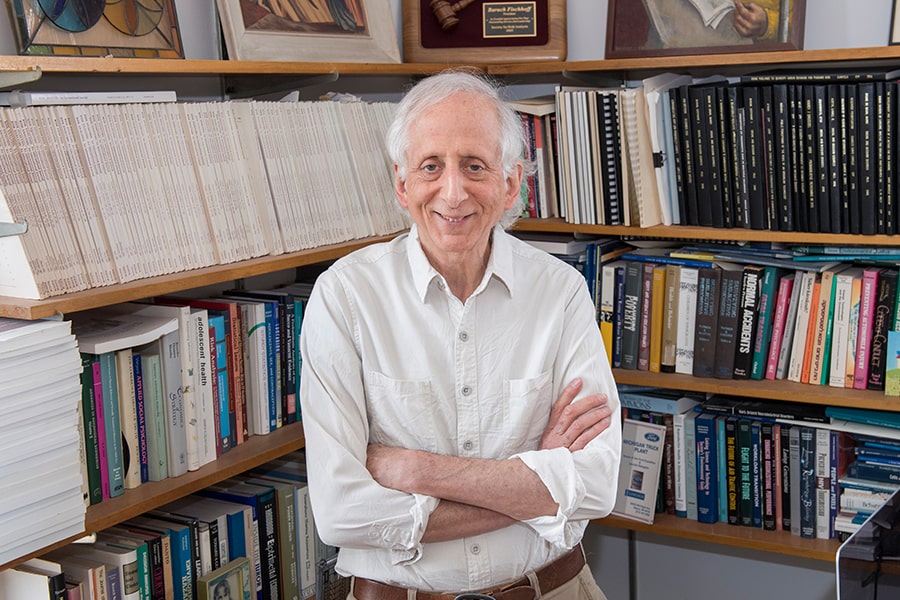
Fischhoff Recruited to Help Devise COVID Vaccine Distribution Plan
NIH and CDC look to CMU's policy expert for guidance
The National Institutes of Health (NIH) and the Centers for Disease Control and Prevention (CDC) could see the problem brewing. Though there is currently no approved vaccine for COVID-19, the virus that has killed over one million people worldwide and infected over 38 million more during a global pandemic, several potential vaccines are on their way. And because any approved vaccine will be developed from scratch, there will be no stockpile, meaning public health officials need to be strategic about who eventually receives the vaccine first.
The NIH and the CDC asked the National Academies of Sciences, Engineering and Medicine to assemble a committee of experts to tackle this challenge. For this unprecedented task, the committee recruited members with diverse professional and personal backgrounds, including Carnegie Mellon University’s Baruch Fischhoff.
"Together, we had the pieces to this puzzle," said Fischhoff, the Howard Heinz University Professor in Carnegie Mellon’s Institute for Politics and Strategy and Department of Engineering and Public Policy. "Our challenge was to pull them together in usable form."
Fischhoff was one of 18 members of the Committee on Equitable Allocation of Vaccine for the Novel Coronavirus, which began work in July and released its recommendations earlier this month. Those recommendations included a four-phase distribution plan that prioritized first responders, healthcare workers, people with underlying conditions, and essential workers before expanding to include the rest of the population. The committee also proposed that everyone receive the vaccine at no out-of-pocket cost, that the program partner with community groups, and that the U.S. engage in the global vaccine effort.
Fischhoff has served on three dozen other National Academy committees, including one in 2017 on "Building Communication Capacity to Counter Infectious Disease Threats." He is an expert in risk and decision sciences, which played key roles in translating the committee’s goals into practical terms. Those goals included fairness, transparency, reliance on scientific evidence, and mitigation of health iniquities.
"One of my roles on the committee was formulating risk-based criteria, consistent with these goals, that allowed setting equitable priorities among groups of people," Fischhoff said. "We settled on four simple criteria. They were, what’s the probability that members of a group will get the disease; what’s the probability that they will have severe health effects if they do get it; what is the risk to society if they are no longer able to function; and then finally, what’s the risk that they will give the disease to other people?"
This framework led to four rollout phases for the vaccine. The first groups to receive the vaccine would be healthcare workers and first responders, people with underlying conditions that put them at a significantly higher risk, and older people living in close quarters like nursing homes.
"[Healthcare workers and first responders] all have three of these risks," Fischhoff said. "They’re likely to get the disease because they’re interacting with people all the time, they pose a big risk to society if they’re not available to us, and they’re likely to give the disease to other people because they’re out and about."
Phase 2 included teachers; those working or living in homeless shelters, group homes or jails; and critical workers in industries that, if they ceased to function, would negatively impact society. Phase 3 would deliver the vaccine to young adults and children, and everyone else would receive it in Phase 4.
Fischhoff also led the chapter of the report on risk communication and community engagement. He said the committee was explicitly charged with communicating how well the program was working, as a necessary condition for earning public trust.
"We addressed the need to let people know what the program is doing so that they could make a fair judgment of how equitably it was allocating the vaccine, and whether they want to take the vaccine themselves, with no attempt to persuade them," Fischhoff said. "Get the facts, get them out, and let people decide."
One audience for the report is the CDC’s Advisory Committee on Immunization Practices, which will make recommendations to the Department of Health and Human Services and, ultimately, the White House. It has also been shared with all the organizations — state, tribal, local, territorial and non-profit — that will be involved in vaccine distribution.
"I hope that the program starts gathering and communicating the facts immediately, in a clear, authoritative way, before misinformation campaigns make that much more difficult," Fischhoff said. "The vaccine program owes that to the American public."